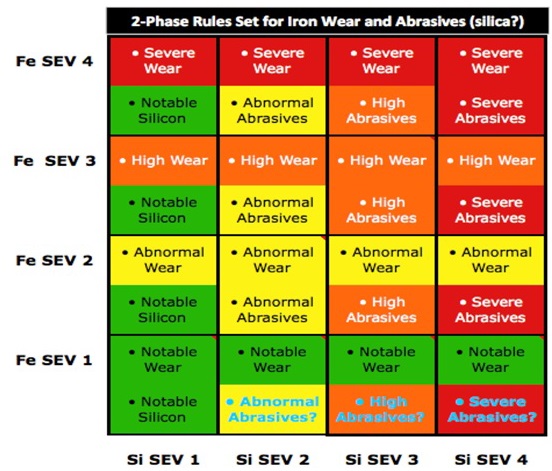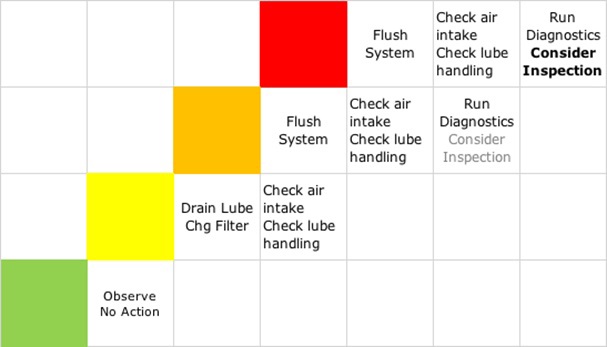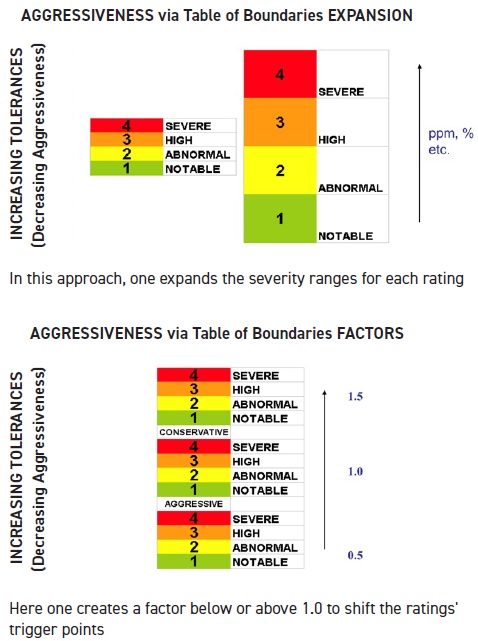Complexity in ISFA (in-service fluid analysis): Part XL
Jack Poley | TLT On Condition Monitoring September 2018
Holistic CM in the 21st Century: Part XII
Last column we presented a two-phase expert rule: Fe versus Si and posed three questions. This is a very common occurrence in ISFA, and there are different ways to view the 16 combinations presented. The proposition matrix and questions are presented herein for easy reference (
see Figure 1).
•
What do you say when Fe is Severity 4 and Si Severity 1?
•
What do you say when Si is Severity 4 and Fe Severity 1?
•
What comments would you make for the remaining 14 propositions?
[Assume nothing else is abnormal so far as available test data.]
[Assume this is a routine sample with no special condition reported.]
2-Phase Rule for Fe & Si Wear vs. Abrasives (?)
 Figure 1. Fe versus Si.
Figure 1. Fe versus Si.
Recall, as well, that the color of the data, once statistically processed, was
sufficient to understand an individual datum’s importance for evaluation purposes. The first question an evaluator would ask is, “What Fe and Si severities existed on the previous sample (and the one before that, etc.)?”
That’s a fair question, but this sample is the first from this component and from a new customer who’s not sampled this component before. Therefore, the evaluator is going to have to make do, i.e., this lone/unsupported example is the
hardest to handle. For that matter, we have to be alert to the fact that our rule is based on data we already have. We, thus, have to hope this particular component operates somewhere between the two extremities of our existing database. Before we go further, what is the minimum amount of data that must exist before we will allow a sample to be processed in our expert system (EXSYS)? Here are things we must know, else we must decline to evaluate:
•
The component’s unique identifier. Name, serial number, asset number, etc.
•
Component type. If we cannot distinguish between a hydraulic pump and a gas turbine, we’ve no business evaluating the data.
•
Sample date. This is the link to trending, and even though we’ve no previous samples, we need to set the table for the chronological process.
This is certainly a skimpy amount of information, but this kind of data sparsity is quite common. Since we are going to evaluate this sample, we must have the component type. Let’s use a
diesel engine as an example (
see Figure 2).
 Figure 2. Diesel engine example.
Figure 2. Diesel engine example.
We can call these four outcomes Lockstep. Fe and Si seem to be directly correlated. These four conditions are the easiest to address because they correlate, providing high confidence. A reasonable assumption is that Fe is mainly wear and Si is mainly abrasive (as dirt/sand). Given a failure has not yet occurred to the best of our knowledge, we might recommend:
•
Green. Flagging for observation only—no action recommended.
•
Yellow. (1.) Drain the lube and change filter. (2.) Check air intake and lube handling/storage. (If this customer prefers a more aggressive approach, we might flush at Yellow.)
•
Orange. (1.) Flush the system according to OEM specs to better purge the abrasives. (2.) Perform diagnostics. (3.) Consider inspection for wear if diagnostics are indicative.
•
Red. (1.) Drain/flush. (2.) Perform diagnostics. (3.) Consider wear inspection even if diagnostics are inconclusive. [Suppress Comment 3 on first sample; revert to Orange.]
Note: Yellow, orange and red are often swing colors, dependent on the customer as to type of possible trauma and aggressiveness (earlier action preferred) desired. It is important the EXSYS be capable of handling such customer preferences without trampling the logic for other customers. Figure 3 illustrates the notion of aggressiveness.
 Figure 3. Aggressiveness.
Figure 3. Aggressiveness.
Expansion and factors are two means by which to dial
aggressiveness (severity) as pertains to coloration of data. Clearly lowering limits for colors to be promoted is a more aggressive treatment that results in a greater percentage of alerts. This can and should be customer-specific on demand.
Aggressiveness deals with the trigger colors so that advisories are matched with objectives for an entity’s ISFA program.
Next comes the rest of the Fe/Si two-phase matrix. Only four slots of 16, the obvious ones, have been accounted for, and one can see that even these
obvious ones have several pivot points. The fringes: Fe red/Si green and Fe green/Si red are the more difficult ones, but we need to fill them in to make the rule complete…next column.